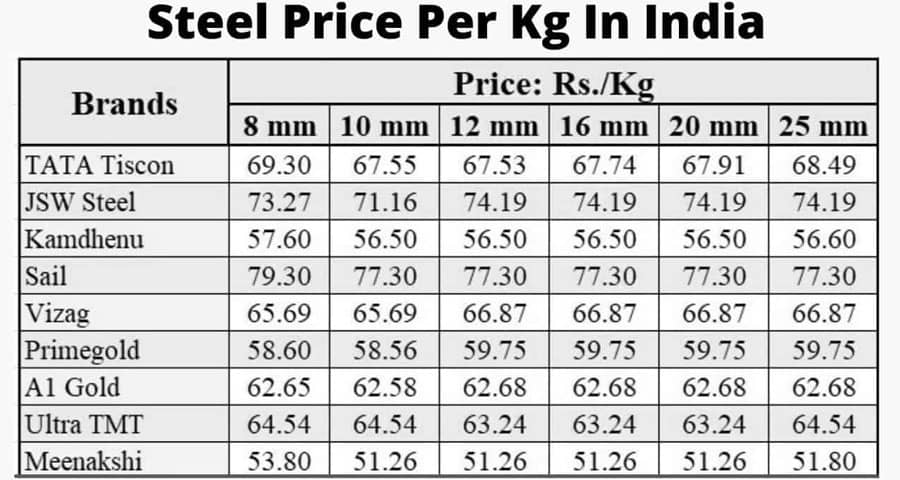Unlocking the Insights into Steel Price Per Kg Today in India

In today's dynamic economic landscape, staying informed about the steel price per kg is essential for various stakeholders, including manufacturers, construction firms, and investors. Understanding the TMT steel price per kg today in India, in particular, holds significant relevance due to the nation's robust industrial and infrastructural activities. Let's delve into the intricacies of steel pricing, factors influencing fluctuations, and the current scenario in the Indian market.
Analyzing Steel Prices: A Comprehensive Overview
Steel, being a vital raw material across multiple industries, experiences fluctuations influenced by diverse factors. From global economic conditions to local market dynamics, various elements contribute to the price of steel per kg. Understanding these factors empowers businesses to make informed decisions and adapt to market changes efficiently.
- Global Economic Trends Impacting Steel Prices: The global economy plays a pivotal role in determining steel prices. Economic indicators such as GDP growth rates, industrial output, and trade policies directly influence demand and supply dynamics, thereby affecting steel prices. Additionally, geopolitical tensions, currency fluctuations, and international trade agreements exert significant influence on global steel pricing trends.
- Regional Market Dynamics in India: In the context of India, a burgeoning economy with a thriving manufacturing and construction sector, steel prices are subject to both domestic and international factors. Rapid urbanization, infrastructural development projects, and government initiatives such as "Make in India" drive steel demand, thus impacting prices. Moreover, regulatory policies, taxation, and raw material availability contribute to the TMT steel price per kg variation across different regions within India.
Factors Influencing Steel Price Fluctuations
Understanding the underlying factors driving fluctuations in steel prices provides valuable insights for businesses and investors. Several key determinants contribute to the volatility observed in steel pricing dynamics:
- Raw Material Costs: The cost of raw materials, including iron ore, coal, and scrap metal, directly influences steel production costs and, consequently, steel prices. Fluctuations in raw material prices, driven by factors such as supply chain disruptions, mining regulations, and environmental policies, impact the overall cost structure of steel production.
- Demand-Supply Dynamics: The balance between steel demand and supply is a critical factor shaping steel prices. Rapid industrialization, infrastructure development, and construction activities drive demand for steel, while production capacity, capacity utilization rates, and inventory levels affect supply dynamics. Any imbalance between demand and supply can lead to price fluctuations in the market.
- Technological Advancements: Advancements in steel manufacturing technologies and processes also influence steel prices. Innovations in production techniques, energy efficiency improvements, and adoption of sustainable practices can impact production costs, thereby affecting the competitiveness of steel pricing in the market.
Current Scenario: Steel Price Per Kg Today in India
As of the latest market update, the steel price per kg in India reflects the dynamic nature of the industry. While specific TMT steel prices per kg today may vary based on factors such as grade, quality, and geographical location, staying updated with real-time market data is crucial for making informed decisions.
- Market Volatility Amidst Economic Recovery: In the wake of the global economic recovery post-pandemic, steel markets have witnessed heightened volatility. Factors such as supply chain disruptions, inflationary pressures, and fluctuating demand patterns have contributed to price fluctuations in the steel sector. However, proactive measures by stakeholders, including capacity expansions, inventory management, and strategic sourcing, mitigate the impact of market volatility.
- Government Initiatives and Policy Reforms: Government initiatives aimed at stimulating economic growth and promoting domestic manufacturing have significant implications for the steel industry. Policy reforms, infrastructure investments, and trade policies influence the demand-supply dynamics and overall competitiveness of the steel sector. As policymakers continue to focus on enhancing the ease of doing business and attracting investments, the steel price per kg in India is poised to reflect these strategic interventions.
Conclusion: Navigating the Complexities of Steel Pricing
In conclusion, understanding the intricacies of steel pricing is essential for businesses and investors operating in today's dynamic market environment. By analyzing global economic trends, regional market dynamics, and key factors influencing price fluctuations, stakeholders can make informed decisions and effectively manage risks associated with steel price per kg variations. As the Indian economy continues to evolve, staying abreast of market developments and leveraging technological advancements will be crucial for maintaining competitiveness in the steel industry.
